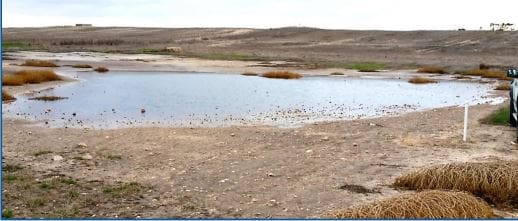A NEW report investigating the extent and impact of seeps on farm land across the Mallee in Victoria and South Australia has confirmed that degradation caused by the fast-growing emergence of high saline seeps could cost the region around $10 million in lost production per year.
 The survey found seeps have become a significant problem for a large number of Mallee growers.
The survey found seeps have become a significant problem for a large number of Mallee growers.
Commissioned by Mallee Sustainable Farming this project is supported by the Natural Resources South Australian Murray-Darling Basin Natural Resources Management Board through funding from the Australian Government’s National Landcare Program, Mallee Catchment Management Authority and the NRM levies.
Seeps occur in the Mallee landscape when rain water drains straight down through the sandy dune until it strikes the clay layer beneath.
This recharge exits at the base of the dune creating a seep. While this area of higher soil moisture can provide some initial productivity increases, over time the seep will draw salinity and eventually render that part of the paddock economically unviable.
Survey coordinator Chris McDonough said Mallee farmers reported seeps were getting worse over the last 10 years with changes to farming systems including spraying out deep-rooted summer weeds allowing more moisture to enter the dune the most likely cause.
The MSF survey estimates seeps could already be directly affecting as many as 250 Mallee farmers.
‘A few farmers have tried managing their seeps by planting some lucerne or strategic tree planting, mostly to mixed success. The one consistent message revealed by the survey was the desperate need for extensive local applied research to find viable solutions.’
Mr McDonough said the report provided strong evidence that seeps were a rapidly growing land degradation problem and the majority of farmers who took part in the survey admitted they were unsure of what to do next about managing and containing seeps.
He said the survey looked at when Mallee farmers first noticed seeps appearing, possible causes and how effective are current control methods.
In terms of actual land currently affected, the Mallee Sustainable Farming survey revealed an average of nine hectares per farm were impacted by a seep for an estimated total across the Mallee of 2250ha.
Mr McDonough said based on the rapid emergence of seeps during the last 10 years, left uncontrolled the area of seeps affected land in the Mallee could potentially grow to 20,000ha over the next decade.
Losing that productive farm land, which might otherwise have yielded an average of 1.7 tonnes/ha at $250/t along with the cost of lost grazing means a loss to the Mallee of $10 million/year.
Source: Mallee Sustainable Farming

HAVE YOUR SAY